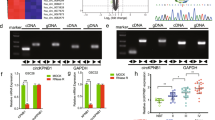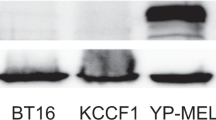Abstract
We have previously reported the construction of a cell cycle-regulated HSV-1 amplicon vector (denoted as pC8-36) that confers luciferase reporter gene activities dependent on cellular divisions. However, luciferase reporter gene is well known for its relatively high sensitivity, thus, it is crucial to evaluate the therapeutic efficacy of a transcriptional targeted vector. In this report, we have engineered the FasL and FADD genes into pC8-36 and demonstrated their efficacy for the treatment of human gliomas in vitro and in vivo. Using trypan blue dye exclusion and TUNEL assay, FasL expression mediated by pC8-36 was shown to induce a significantly higher percentage of cell death in proliferating cells than those observed in the G1-arrested cells. The observed cell killing effect correlated well with the level of FasL protein expression when analyzed by ELISA assay. Furthermore, the incorporation of both FasL and FADD into pC8-36 resulted in the enhancement of apoptosis in the target glioma cells both in vitro and in vivo. Targeting proliferating tumor cells via the transcriptional control of therapeutic genes could potentially improve the safety and efficacy of cancer gene therapy, and thus would allow the development of strategies for more effective anticancer therapies.
This is a preview of subscription content, access via your institution
Access options
Subscribe to this journal
Receive 12 print issues and online access
$259.00 per year
only $21.58 per issue
Buy this article
- Purchase on Springer Link
- Instant access to full article PDF
Prices may be subject to local taxes which are calculated during checkout





Similar content being viewed by others
References
Ho IA, Hui KM, Lam P . Glioma-specific and cell cycle-regulated Herpes Simplex Virus Type 1 amplicon viral vector. Hum Gene Ther 2004; 15: 495–508.
Cosman D . A family of ligands for the TNF receptor superfamily. Stem Cells 1994; 12: 440–455.
Rubinchik S, Wang D, Yu H, Fan F, Luo M, Norris J et al. A complex adenovirus vector that delivers FasL-GFP with combined prostate-specific and tetracycline-regulated expression. Mol Ther 2001; 4: 416–426.
Nagata S . Fas ligand-induced apoptosis. Annu Rev Genet 1999; 33: 29–55.
Choi C, Benveniste EN . Fas ligand/Fas system in the brain: regulator of immune and apoptotic responses. Brain Res Brain Res Rev 2004; 44: 65–81.
Weller M, Frei K, Groscurth P, Krammer P, Yonekawa Y, Fontana A . Anti-Fas/APO-1 antibody-mediated apoptosis of cultured human glioma cells, induction and modulation of sensitivity by cytokines. J Clin Invest 1994; 94: 954–964.
Weller M, Malipiero U, Rensing-Ehl A, Barr P, Fontana A . Fas/APO-1 gene transfer for human malignant glioma. Cancer Res 1995; 55: 2936–2944.
Karlsson T, Henriksson R, Hedman H . Induction of apoptosis in resistant glioma cells by synthetic caspase-activation. J Neuro-Oncol 2004; 66: 71–79.
Chinnaiyan A, O'Rourke K, Tewari M, Dixit V . FADD, a novel death domain-containing protein, interacts with the death domain of FAS and initiates apoptosis. Cell 1995; 81: 505–512.
Chinnaiyan A, Tepper C, Seldin M, O'Rourke K, Kischkel F, Hellbardt S et al. FADD/MORT1 is a common mediator of CD95 (Fas/APO-1) and tumor necrosis factor receptor-induced apoptosis. J Biol Chem 1996; 271: 4961–4965.
Grimm S, Stanger B, Leder P . RIP and FADD: two ‘death domain’ – containing proteins can induce apoptosis by convergent, but dissociable, pathways. Proc Natl Acad Sci USA 1996; 93: 10923–10927.
Kondo S, Ishizaka Y, Okada T, Kondo Y, Hitomi M, Tanaka Y et al. FADD gene therapy for malignant gliomas in vitro and in vivo. Hum Gene Ther 1998; 9: 1599–1608.
Liu N, Lucibello FC, Korner K, Wolfraim LA, Zwicker J, Müller R . CDF-1, a novel E2F-unrelated factor, interacts with cell cycle-regulated repressor elements in multiple promoters. Nucleic Acids Res 1997; 25: 4915–4920.
Saeki Y, Breakefield XO, Chiocca EA . Improved HSV-1 amplicon packaging system using ICP27-deleted, oversized HSV-1 BAC DNA. Methods Mol Med 2003; 76: 51–60.
Olschowka JA, Bowers WJ, Hurley SD, Mastrangelo MA, Federoff HJ . Helper-free HSV-1 amplicons elicit a markedly less robust innate immune response in the CNS. Mol Ther 2003; 7: 218–227.
Bergers G, Javaherian K, Lo KM, Folkman J, Hanahan D . Effects of angiogenesis inhibitors on multistage carcinogenesis in mice. Science 1999; 284: 808–812.
Jiang Z, Zheng X, Lytle RA, Higashikubo R, Rich KM . Lovastatin-induced up-regulation of the BH3-only protein, Bim, and cell death in glioblastoma cells. J Neurochem 2004; 89: 168–178.
Schmidt F, Groscurth P, Kermer M, Dichgans J, Weller M . Lovastatin and phenylacetate induce apoptosis, but not differentiation, in human malignant glioma cells. Acta Neuropathol. (Berlin) 2001; 101: 217–224.
Acknowledgements
We thank Dr R Müller (Institute of Molecular Biology and Tumor Research, Germany) for providing us with the plasmids GalcycA, Dr MV Clement (National University of Singapore) for providing us the FADD cDNA and Dr Nai-dy Wang (National University of Singapore) for valuable discussions. This research was supported by grants from the Singapore National Medical Research Council (NMRC) and Singapore Biomedical Research Council (BMRC).
Author information
Authors and Affiliations
Corresponding author
Rights and permissions
About this article
Cite this article
Ho, I., Hui, K. & Lam, P. Targeting proliferating tumor cells via the transcriptional control of therapeutic genes. Cancer Gene Ther 13, 44–52 (2006). https://doi.org/10.1038/sj.cgt.7700864
Received:
Revised:
Accepted:
Published:
Issue Date:
DOI: https://doi.org/10.1038/sj.cgt.7700864
Keywords
This article is cited by
-
FasL and FADD delivery by a glioma-specific and cell cycle-dependent HSV-1 amplicon virus enhanced apoptosis in primary human brain tumors
Molecular Cancer (2010)
-
Progress and prospects: Biological properties and technological advances of herpes simplex virus type 1-based amplicon vectors
Gene Therapy (2009)
-
An Efficient and Safe Herpes Simplex Virus Type 1 Amplicon Vector for Transcriptionally Targeted Therapy of Human Hepatocellular Carcinomas
Molecular Therapy (2007)



